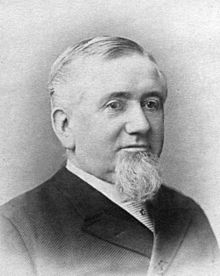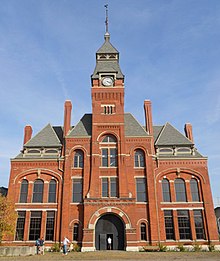
Eugene Victor Debs was an American socialist, political activist, trade unionist, one of the founding members of the Industrial Workers of the World (IWW), and five-time candidate of the Socialist Party of America for President of the United States. Through his presidential candidacies as well as his work with labor movements, Debs eventually became one of the best-known socialists living in the United States.
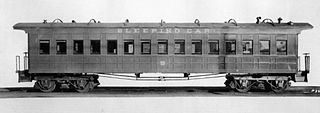
The sleeping car or sleeper is a railway passenger car that can accommodate all passengers in beds of one kind or another, for the purpose of sleeping. George Pullman was the American innovator of the sleeper car.

The Pullman Strike was two interrelated strikes in 1894 that shaped national labor policy in the United States during a period of deep economic depression. First came a strike by the American Railway Union (ARU) against the Pullman factory in Chicago in spring 1894. When it failed, the ARU launched a national boycott against all trains that carried Pullman passenger cars. The nationwide railroad boycott that lasted from May 11 to July 20, 1894, was a turning point for US labor law. It pitted the American Railway Union (ARU) against the Pullman Company, the main railroads, the main labor unions, and the federal government of the United States under President Grover Cleveland. The strike and boycott shut down much of the nation's freight and passenger traffic west of Detroit, Michigan. The conflict began in Chicago, on May 11 when nearly 4,000 factory employees of the Pullman Company began a wildcat strike in response to recent reductions in wages. Most of the factory workers who built Pullman cars lived in the "company town" of Pullman just outside of Chicago. Pullman was designed as a model community by its namesake founder and owner George Pullman. Jennie Curtis who lived in Pullman was president of seamstress union ARU LOCAL 269 gave a speech at the ARU convention urging people to strike.

Asa Philip Randolph was an American labor unionist and civil rights activist. In 1925, he organized and led the Brotherhood of Sleeping Car Porters, the first successful African-American-led labor union. In the early Civil Rights Movement and the Labor Movement, Randolph was a prominent voice. His continuous agitation with the support of fellow labor rights activists against racist labor practices helped lead President Franklin D. Roosevelt to issue Executive Order 8802 in 1941, banning discrimination in the defense industries during World War II. The group then successfully maintained pressure, so that President Harry S. Truman proposed a new Civil Rights Act and issued Executive Orders 9980 and 9981 in 1948, promoting fair employment and anti-discrimination policies in federal government hiring, and ending racial segregation in the armed services.

Pullman, one of Chicago's 77 defined community areas, is a neighborhood located on the city's South Side. Twelve miles from the Chicago Loop, Pullman is situated adjacent to Lake Calumet.

The Pullman Company, founded by George Pullman, was a manufacturer of railroad cars in the mid-to-late 19th century through the first half of the 20th century, during the boom of railroads in the United States. Through rapid late-19th century development of mass production and takeover of rivals, the company developed a virtual monopoly on production and ownership of sleeping cars.

The American Railway Union (ARU) was briefly among the largest labor unions of its time and one of the first industrial unions in the United States. Launched at a meeting held in Chicago in February 1893, the ARU won an early victory in a strike on the Great Northern Railroad in the summer of 1894. This successful strike was followed by the bitter 1894 Pullman Strike in which government troops and the power of the judiciary were enlisted against the ARU, ending with the jailing of the union's leadership for six months in 1895 and effectively crushing the organization. The group's blacklisted and dispirited remnants finally disbanded the organization via amalgamation into the Social Democracy of America (SDA) at its founding convention in June 1897.

Founded in 1925, the Brotherhood of Sleeping Car Porters and Maids was the first labor organization led by African Americans to receive a charter in the American Federation of Labor (AFL). The BSCP gathered a membership of 18,000 passenger railway workers across Canada, Mexico, and the United States.
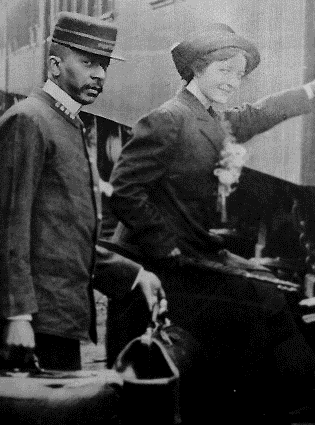
Pullman porters were men hired to work for the railroads as porters on sleeping cars. Starting shortly after the American Civil War, George Pullman sought out former slaves to work on his sleeper cars. Their job was to carry passengers’ baggage, shine shoes, set up and maintain the sleeping berths, and serve passengers. Pullman porters served American railroads from the late 1860s until the Pullman Company ceased its United States operations on December 31, 1968, though some sleeping-car porters continued working on cars operated by the railroads themselves and, beginning in 1971, Amtrak. The Pullman Company also operated sleeping cars in Mexico from the 1880s until November 13, 1970. The term "porter" has been superseded in modern American usage by "sleeping car attendant", with the former term being considered "somewhat derogatory".

The Alton Railroad was the final name of a railroad linking Chicago to Alton, Illinois; St. Louis, Missouri; and Kansas City, Missouri. Its predecessor, the Chicago and Alton Railroad, was purchased by the Baltimore and Ohio Railroad in 1931 and was controlled until 1942 when the Alton was released to the courts. On May 31, 1947, the Alton Railroad was merged into the Gulf, Mobile and Ohio Railroad. Jacob Bunn had been one of the founding reorganizers of the Chicago & Alton Railroad Company during the 1860s.

Solon Spencer Beman was an American architect based in Chicago, Illinois and best known as the architect of the planned Pullman community and adjacent Pullman Company factory complex, as well as Chicago's renowned Fine Arts Building. Several of his other largest commissions, including the Pullman Office Building, Pabst Building, and Grand Central Station in Chicago, have since been demolished. Beman designed numerous Christian Science churches and influenced the design of countless more.
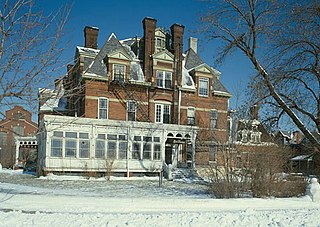
The Hotel Florence is a former hotel located in the Pullman Historic District on the far south side of Chicago, Illinois. It was built in 1881 to a design by architect Solon Spencer Beman. Since 1991, it has been owned by the Illinois Historic Preservation Agency.

The George Washington was a named passenger train of the Chesapeake and Ohio Railway running between Cincinnati, Ohio and Washington, D.C. that operated from 1932, the 200th anniversary of the birth of George Washington, to 1974. A section divided from the main train at Gordonsville, Virginia and operated through Richmond to Phoebus, Virginia. From the west, a section originated in Louisville and joined at Ashland.
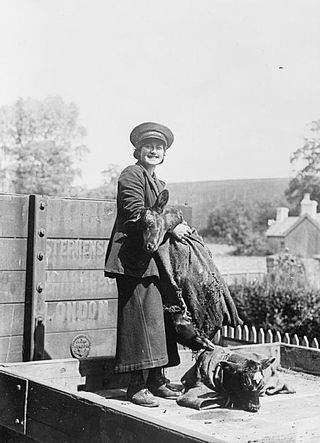
A porter is a railway employee. The role of a porter is to assist passengers at railway stations, and to handle the loading, unloading, and distribution of luggage and parcels. In the United States the term was formerly used for employees who attended to passengers aboard sleeping cars, a usage unknown to British or Commonwealth English where such staff are known as attendants or stewards, terms which are also common in translation in non-English speaking European train travel.

Pullman National Historical Park is a historic district located in Chicago, Illinois, United States, which in the 19th century was the first model, planned industrial community in the United States. The district had its origins in the manufacturing plans and organization of the Pullman Company and became one of the most well-known company towns in the United States, as well as the scene of the violent 1894 Pullman strike. It was built for George Pullman as a place to produce the Pullman railroad-sleeping cars.

The Pullman Memorial Universalist Church of Albion, New York was constructed in 1894 as a memorial to the parents of inventor and industrialist George Mortimer Pullman. The structure, built of pink Medina sandstone and featuring fifty-six Tiffany stained glass windows and a Johnson pipe organ, is in the Orleans County Courthouse National Historic District. The building has been in constant use since its opening; the congregation affiliating with the Unitarian Universalist Association in 1961 but keeping its historic name.
Clayton Mark, one of the pioneer makers of steel pipe in the United States, was an industrialist in the Chicago area who founded the Mark Manufacturing Company in 1888, a firm for the fabrication and sale of water-well supplies and Clayton Mark and Company in 1900. In addition, Mark founded Marktown, a planned worker community in Northwest Indiana on the National Register of Historic Places. He was known for his philanthropy and civic contributions.
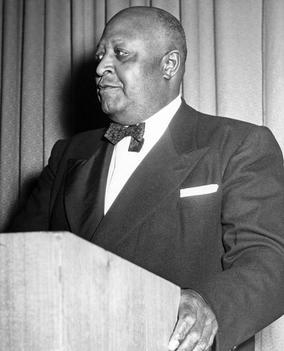
Milton Price Webster was an American trade unionist, best remembered as the first vice president of the Brotherhood of Sleeping Car Porters and leader of its Chicago division. As the union's lead negotiator, Webster was influential in securing a collective bargaining agreement with the Pullman Company – the first national contract won by any black-led American trade union.
